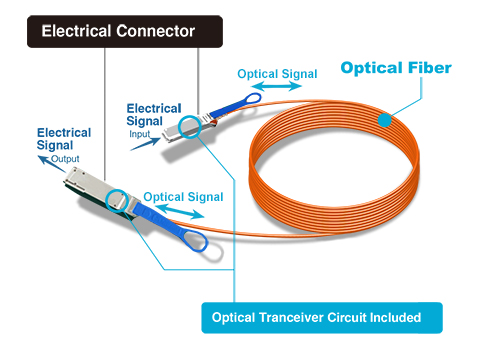Direct attach copper cables (DACs) and active optical cables (AOCs) are widely used in data centers to support high transfer rates between switches, servers and storage devices. But compared with DAC, AOC cables have more advantages. And now 40 Gigabit Ethernet prevails in higher data transmission, which leads to the popularity of 40G AOCs such as 40G QSFP+ to 4xSFP+ AOC, 40G QSFP+ to 8xLC AOC, 40G QSFP+ to QSFP+ AOC, etc. However, another problem arises. Facing a large number of types of 40G AOC cables, do you know which one is perfect for your network? This post may help you solve this problem.
As we all know, active optical cable (AOC cable) is a kind of optical cable that uses electrical-to-optical conversion on the cable ends to improve speed and distance performance of the cable without sacrificing compatibility with standard electrical interfaces, which is different from direct attach copper cables. And 40G AOC is a type of active optical cable that is terminated with 40GBASE QSFP+ connector on one end. And on the other end, it can be terminated with LC connectors, QSFP+ connectors or SFP+ connectors. The 40G AOC offers four independent data transmission channels and four data receiving channels via the multimode ribbon fibers, and each capable of 10Gb/s operation. With the advantages of high transmission rate, long transmission distance and low energy consumption, 40G AOC cable is ideal for data center and other applications.
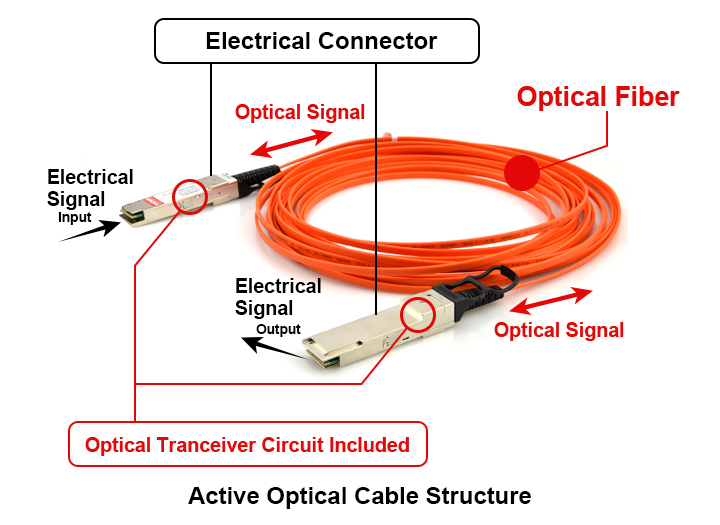
Compared with 40G DACs (direct attach cables), 40G AOCs have great benefits.
- 40G AOCs have longer reach, lower weight and tighter bend radius, which allows for simpler cable management and better airflow for cooling.
- 40G AOCs do not need to use extra fiber patch cables, which can save cost.
- Deploying AOCs can simplify the troubleshooting process, for there are no cleanliness issues in optical connector and users do not need to do termination plug and test.
Since there is a limitation of copper cables, nowadays various types of 40G AOCs have been launched in the market. Here is a simple overview of 40G AOCs.
40G QSFP+ to QSFP+ active optic cables are a high performance, low power consumption, long reach interconnect solution supporting 40G Ethernet, Fibre Channel and PCIe. It is compliant with the QSFP MSA and IEEE P802.3ba 40GBASE-SR4. 40G AOC has four full duplex lanes, where each lane is capable of transmitting data at rates up to 10Gb/s, providing an aggregated rate of 40Gb/s.
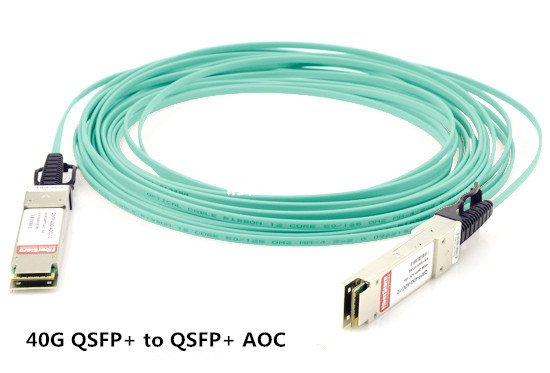
As its name shows, the 40G QSFP+ to 4xSFP+ AOC contains a 40G QSFP+ connector on one end and four separate 10G SFP+ connectors at the other ends. It is intended for 40G to 4×10G applications. This 40G to 10G AOC is a high performance cable for short-range multi-lane data communication and interconnect applications. For typical application, users can install this splitter active optical cable between an available QSFP+ port on their 40 Gbps rated switch and feed up to four upstream 10G SFP+ enabled switches. Each QSFP+ to SFP+ splitter AOC descriptions a single QSFP+ connector rated for 40Gbps on one end and four SFP+ connectors on the other, each rated for 10Gb/s. With this special features, 40G QSFP+ to 4xSFP+ AOC offers a cost-effective ways for IT professionals for merging 40G QSFP+ and 10G SFP+ enabled host adapters, switches and servers.
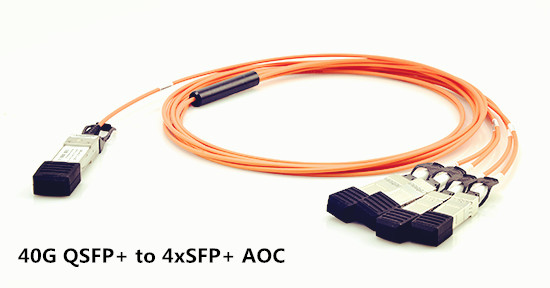
40G QSFP+ to 8xLC AOC also has four full duplex parallel channels. And transmission data rate of each channel is up to 10.3Gbit/s. It provides connectivity between devices using QSFP+ port on one end and 8xLC connectors on the other end. This AOC offers 40GbE systems the ability to connect 10G switches or adapter cards. And they are suitable for short distances and provide a highly cost-effective way to connect within racks and across adjacent racks.
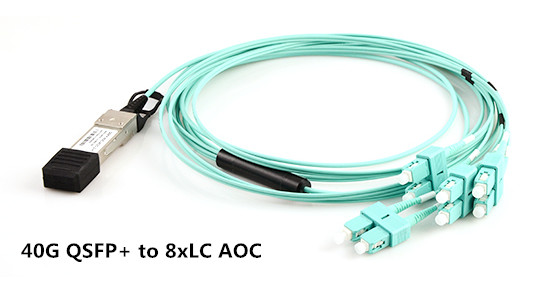
As an alternative to copper links in high-performance computing and data center environments, active optical cables keep growing and have a great prospect. And 40G AOCs play an important role in many fields as well as enhancing the process of the traditional data center to step into optical interconnection. Choosing a right type of 40G AOCs also has profound significance. FS.COM supplies various kinds of 40G AOCs to meet your demands. Welcome to visit FS.COM for more detailed information.

